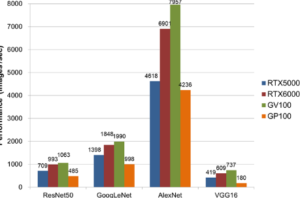Benchmark Nvidia RTX 5000 vs RTX 5500
In this article we will compare two of their toptier GPUs: the Nvidia RTX 5000 and RTX 5500. We’ll delve into their specifications performance applications and help you decide which one is the better choice for your specific requirements.
What Are Nvidia RTX 5000 and RTX 5500?
Before we jump into the comparison let get familiar with these two GPUs.
- Nvidia RTX 5000: This GPU is part of the Nvidia Quadro series designed for professionals who need highperformance computing. It based on the Turing architecture and comes with 16GB of GDDR6 VRAM. The RTX 5000 is known for its exceptional rendering capabilities and is commonly used in workstations for 3D rendering CAD and scientific simulations.
- Nvidia RTX 5500: Similar to the RTX 5000 the RTX 5500 is also a member of the Quadro series. It shares the same Turing architecture but packs 8GB of GDDR6 VRAM. This GPU is aimed at professionals who require high graphics performance for tasks like video editing 3D modeling and design work.
Specifications and Features
Nvidia RTX 5000:
- VRAM: 16GB GDDR6
- CUDA Cores: 3072
- Tensor Cores: 384
- RT Cores: 48
- Memory Bandwidth: 448 GB/s
- Max Power Consumption: 265W
Nvidia RTX 5500:
- VRAM: 8GB GDDR6
- CUDA Cores: 2048
- Tensor Cores: 256
- RT Cores: 32
- Memory Bandwidth: 256 GB/s
- Max Power Consumption: 150W
Performance Comparison
When it comes to performance the RTX 5000 holds a clear advantage. With more CUDA cores and higher VRAM it outperforms the RTX 5500 in tasks that demand substantial graphics processing power. The RTX 5500 on the other hand is no slouch and is more powerefficient making it a good choice for professionals who value a balance between performance and power consumption.
Applications and Use Cases
Both the RTX 5000 and RTX 5500 are designed for professional use. The RTX 5000 excels in tasks like 3D rendering complex simulations and scientific computing. It the goto choice for industries that require toptier graphics performance. The RTX 5500 with its balance of power and efficiency suits professionals in fields like video editing graphic design and architectural modeling.
Price and Value
The RTX 5000 is the more expensive option and its price reflects its superior performance. The RTX 5500 while being a budgetfriendly alternative provides great value for professionals who don’t require the sheer power of the RTX 5000.
Pros and Cons of RTX 5000
Pros:
- Exceptional performance
- Ample VRAM for complex tasks
- Suitable for scientific simulations
Cons:
- Higher power consumption
- Premium price
Pros and Cons of RTX 5500
Pros:
- Balanced performance and power efficiency
- Affordable
- Ideal for design and video editing
Cons:
- Not as powerful as RTX 5000
Which GPU is Right for You?
Choosing between the RTX 5000 and RTX 5500 depends on your specific needs. If you’re in a field that demands toptier graphics performance and can accommodate the higher power consumption the RTX 5000 is your best bet. However if you’re looking for a GPU that strikes a balance between performance and price the RTX 5500 is a solid choice.
Future Upgrades and Considerations
Both GPUs are based on Nvidia Turing architecture which means they support realtime ray tracing and AIdriven features. As technology advances future software and applications may take advantage of these capabilities ensuring that your investment remains relevant for years to come.
Final Word
In the battle of Nvidia RTX 5000 vs RTX 5500 the winner depends on your specific requirements. Consider the nature of your work budget and power consumption constraints before making your decision.
FAQs
FAQ 1: Is the RTX 5500 significantly better than the RTX 5000?
The RTX 5000 offers superior performance but whether it “better” depends on your specific needs. If you require highend graphics processing the RTX 5000 is the way to go. However the RTX 5500 provides a great balance between performance and cost.
FAQ 2: Are these GPUs suitable for gaming?
While these GPUs are primarily designed for professional use they can handle gaming. However gamingspecific GPUs may provide a better experience for gamers.
FAQ 3: Can I use RTX 5000 and RTX 5500 for machine learning?
Yes both GPUs are capable of handling machine learning tasks thanks to their Turing architecture and Tensor Cores.
FAQ 4: What are the major differences in architecture between RTX 5000 and RTX 5500?
The main differences lie in the number of CUDA cores VRAM and power consumption. The RTX 5000 has more power under the hood.
FAQ 5: How do these GPUs compare to other Nvidia models?
Both GPUs offer excellent performance but Nvidia has a wide range of GPUs designed for different purposes. Consider your specific needs and budget when comparing them to other models.

Source of image: Google



